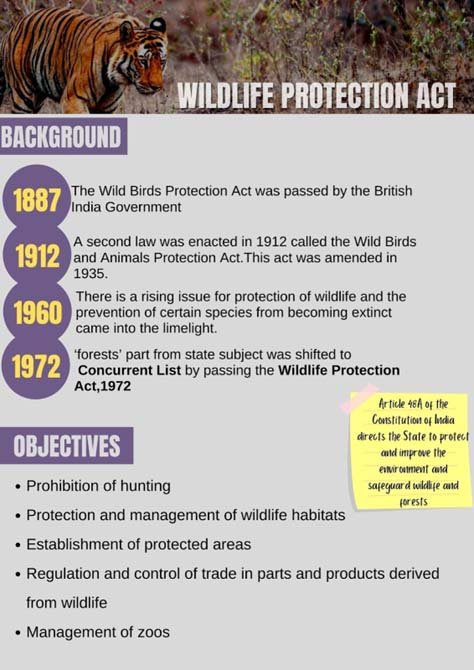Arif and his Sarus crane : What law is he booked under, what penalty he faces?
Context- On March 9, Mohammad Arif, a 35-year-old man from Mandkha, Uttar Pradesh, was booked under the Wildlife Protection Act, 1972, for “illegally” keeping and nursing an injured Sarus crane (Grus Antigone) he found in his village.
The Sarus crane is usually found in wetlands and is the state bird of Uttar Pradesh. Standing at 152-156 centimetres, it is the world’s tallest flying bird.

(Credits- The Indian Wire)
What is the Wildlife Protection Act?
- The Wildlife Protection Act came into force on September 9, 1972, to “provide for the protection” of wild animals, birds and plants to ensure the “ecological and environmental security of the country.”
- It aims to conserve protected species in two main ways: firstly, by prohibiting their hunting and secondly by protecting their habitat through the creation and regulation of sanctuaries, national parks, reserves, etc.
- Further, the Act prohibits capturing or hunting any species of animals listed under Schedules I-IV, barring a few exceptions such as hunting a diseased or dangerous animal or bird constituting a threat to human life or property or for scientific research or management.
- Broadly, offences under the Act can be divided into three categories; hunting under Sections 9, 17A, and 2(16); unauthorised possession, transport, and trade under Sections 40, 42, 43, 48, 48A, 49 and Chapter VA; and offences related to protected areas or habitat destruction under Sections 27, 29-36 and 38.
What are the Schedules listed in the Act?
- The Act protects wild and captive animals or birds which belong to a species listed under Schedules I-IV.
- Species falling under Schedules I and II are classified as “Strictly Protected Species.” No wild or captive animal or any products derived from them, like their fur, skin, tusks, etc., can be possessed without an ownership certificate under Section 42.
- These animals cannot be transferred or acquired by any means other than inheritance, barring exceptions like peacock tail feathers or captive elephants.
What is the law on animals and birds under Schedule IV?
- Species mentioned under Schedules III and IV of the Wildlife Protection Act are governed by Sections 44, 48, and 49, which relate to the prohibition on dealings in trophy and animal articles without a license, purchase of animals by a licensee, and restriction on transportation of wildlife.
- Section 48 of the Act specifically states that any wild animal or animal article can be transported only after obtaining permission from the Chief Wildlife Warden or any other officer authorised by the State Government on their behalf.
What are the penalties for violating the provisions of the WPA?
- Section 51 says that any person who contravenes any provision of the Act, except those on trade, commerce, and taxidermy of certain animals and the prohibition on teasing animals in a zoo having separate penalties, shall be punished with up to three years imprisonment or fine up to Rs. 25,000 rupees or both. This also extends to any rule, order, or breach of conditions of a license or permit.
What are the powers of the state government?
- It was in 1976, with the advent of the 42nd Amendment Act, that the subject of “Forests and Protection of Wild Animals and Birds” was transferred from State to Concurrent List. However, state governments still enjoy a host of powers under the WPA, 1972.
- Section 4 allows the State government to appoint a Chief Wildlife Warden alongside wildlife wardens, honorary wildlife wardens, and other officers and employees.
- In addition, Section 6 empowers the state to constitute a State Board for Wild Life, consisting of the Chief Minister as chairperson, the Minister in charge of Forests and Wildlife as the vice chairperson, and at least three members of the State legislature, among others.
- State governments can also add or delete any entry to or from any Schedule or transfer any entry from one part of a Schedule to another, provided that any such alteration made by the State Government is done with the previous consent of the Centre, under Section 61.
- Besides this, under Section 64, state governments can notify certain rules, including the conditions subject to which any license or permit may be granted or under which the officers will be authorised to file cases in court.
What is the 2022 Amendment to the WPA?
- On August 2, 2022, the Rajya Sabha introduced the Wildlife (Protection) Amendment Bill, 2022, which sought to bring in changes like reducing the number of Schedules and increasing penalties under the Act.
- It seeks to implement the provisions of CITES, an international agreement between governments ensuring international trade of wild animals and plant species does not threaten their survival.
- Importantly, the Amendment seeks to reduce the number of schedules from VI to IV, whereby Schedule V, for vermin or animals that destroy food crops, will be done away with.
- The revised Act also accords greater powers to the Centre concerning the export, import, regulation, prohibition, and trade of plant or animal species, through a designated Management Authority.
Conclusion- Proposed amendments to WPA 1972 will future strengthen protection for wild animals, while also simplifying the law at the same time.
Source- Indian Express
NEWS- Arif and his Sarus crane : What law is he booked under, what penalty he faces?
Syllabus- GS-3; Environment


